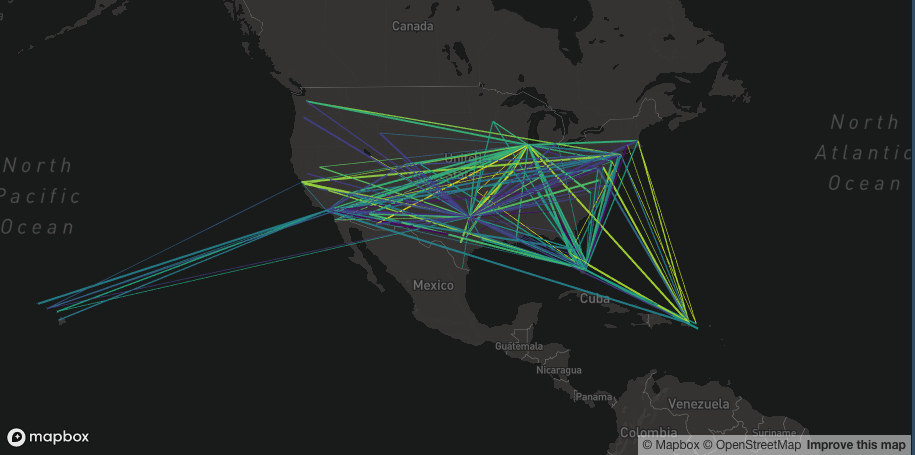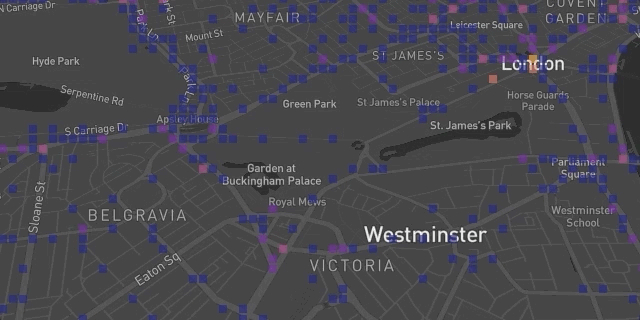Layers
layer_id
Each layer requires a layer_id value. If you don’t supply one, it will create it for you, but this may have some unintended consequences for you.
The layer_id is the ID that deck.gl uses to ‘shallow-compare’ layers to see if they need updating. Which comes in handy when working in Shiny. If you update data, for example when using a reactive() function, and use the same layer_id, deck.gl knows it should update the layer rather than re-draw it completely.
However, if two of your layers of the same type have the same layer_id, then deck.gl will get confused and will only show the last layer drawn.
For example, if you have to scatterplot layers, both with the same layer_id, only the second one will be shown.
Arcs
url <- 'https://raw.githubusercontent.com/plotly/datasets/master/2011_february_aa_flight_paths.csv' flights <- read.csv(url) flights$id <- seq_len(nrow(flights)) flights$stroke <- sample(1:3, size = nrow(flights), replace = T) mapdeck( token = key, style = mapdeck_style("dark"), pitch = 45 ) %>% add_arc( data = flights , layer_id = "arc_layer" , origin = c("start_lon", "start_lat") , destination = c("end_lon", "end_lat") , stroke_from = "airport1" , stroke_to = "airport2" , stroke_width = "stroke" )

Arcs
Animated Arcs
mapdeck( token = key, style = 'mapbox://styles/mapbox/dark-v9', pitch = 45 ) %>% add_animated_arc( data = flights , layer_id = "arc_layer" , origin = c("start_lon", "start_lat") , destination = c("end_lon", "end_lat") , stroke_from = "airport1" , stroke_to = "airport2" , stroke_width = "stroke" )
Arcs
GeoJSON
mapdeck( token = key , pitch = 35 ) %>% add_geojson( data = geojson , layer_id = "geojson" )

GeoJSON
Great Circles
url <- 'https://raw.githubusercontent.com/plotly/datasets/master/2011_february_aa_flight_paths.csv' flights <- read.csv(url) flights$id <- seq_len(nrow(flights)) flights$stroke <- sample(1:3, size = nrow(flights), replace = T) mapdeck( style = 'mapbox://styles/mapbox/dark-v9') %>% add_greatcircle( data = flights , layer_id = "arc_layer" , origin = c("start_lon", "start_lat") , destination = c("end_lon", "end_lat") , stroke_from = "airport1" , stroke_to = "airport2" , stroke_width = "stroke" )

Great Circles
Grid
df <- read.csv(paste0( 'https://raw.githubusercontent.com/uber-common/deck.gl-data/master/', 'examples/3d-heatmap/heatmap-data.csv' )) df <- df[!is.na(df$lng), ] mapdeck( token = key, style = mapdeck_style("dark"), pitch = 45 ) %>% add_grid( data = df , lat = "lat" , lon = "lng" , cell_size = 5000 , elevation_scale = 50 , layer_id = "grid_layer" )

Grid
Heatmap
df <- read.csv(paste0( 'https://raw.githubusercontent.com/uber-common/deck.gl-data/master/', 'examples/3d-heatmap/heatmap-data.csv' )) df <- df[!is.na(df$lng), ] mapdeck( style = mapdeck_style('dark'), pitch = 45 ) %>% add_heatmap( data = df[1:30000, ] , lat = "lat" , lon = "lng" , weight = "weight", , colour_range = colourvalues::colour_values(1:6, palette = "inferno") )

Heatmap
Hexagons
library(mapdeck) set_token( read.dcf("~/Documents/.googleAPI", fields = "MAPBOX")) df <- read.csv(paste0( 'https://raw.githubusercontent.com/uber-common/deck.gl-data/master/examples/' , '3d-heatmap/heatmap-data.csv' )) df <- df[!is.na(df$lng), ] mapdeck( style = mapdeck_style("dark"), pitch = 45) %>% add_hexagon( data = df[ df$lat > 54.5, ] , lat = "lat" , lon = "lng" , layer_id = "hex_layer" , elevation_scale = 100 , colour_range = colourvalues::colour_values(1:6, palette = colourvalues::get_palette("viridis")[70:256,]) )

Hexagons
Lines
url <- 'https://raw.githubusercontent.com/plotly/datasets/master/2011_february_aa_flight_paths.csv' flights <- read.csv(url) flights$id <- seq_len(nrow(flights)) flights$stroke <- sample(1:3, size = nrow(flights), replace = T) mapdeck( token = key, style = mapdeck_style("dark"), pitch = 45 ) %>% add_line( data = flights , layer_id = "line_layer" , origin = c("start_lon", "start_lat") , destination = c("end_lon", "end_lat") , stroke_colour = "airport1" , stroke_width = "stroke" )

Lines
Path
mapdeck( token = key , style = mapdeck_style("dark") , zoom = 10) %>% add_path( data = roads , stroke_colour = "RIGHT_LOC" , layer_id = "path_layer" )

Path
Point cloud
df <- capitals df$z <- sample(10000:10000000, size = nrow(df)) mapdeck(token = key, style = mapdeck_style("dark")) %>% add_pointcloud( data = df , lon = 'lon' , lat = 'lat' , elevation = 'z' , layer_id = 'point' , fill_colour = "country" )

Pointcloud
Polygons
library(sf) library(geojsonsf) sf <- geojson_sf("https://symbolixau.github.io/data/geojson/SA2_2016_VIC.json") sf$e <- sf$AREASQKM16 * 10 mapdeck(token = key, style = mapdeck_style("dark")) %>% add_polygon( data = sf[ data.table::`%like%`(sf$SA4_NAME16, "Melbourne"), ] , layer = "polygon_layer" , fill_colour = "SA2_NAME16" , elevation = "e" )

Polygons
Scatter
mapdeck( token = key ) %>% add_scatterplot( data = capitals , lat = "lat" , lon = "lon" , radius = 500000 , fill_colour = "country" , layer_id = "scatter_layer" , palette = "plasma" )

Scatter
Screen grid
df <- read.csv(paste0( 'https://raw.githubusercontent.com/uber-common/deck.gl-data/master/', 'examples/3d-heatmap/heatmap-data.csv' )) df <- df[ !is.na(df$lng), ] df$weight <- sample(1:10, size = nrow(df), replace = T) mapdeck( token = key, style = mapdeck_style('dark'), pitch = 45 ) %>% add_screengrid( data = df , lat = "lat" , lon = "lng" , weight = "weight" , layer_id = "screengrid_layer" , cell_size = 10 , opacity = 0.3 , colour_range = colourvalues::colour_values(1:6, palette = "plasma") )

Screengrid
Text
mapdeck(token = key, style = mapdeck_style('dark')) %>% add_text( data = capitals , lon = 'lon' , lat = 'lat' , fill_colour = 'country' , text = 'capital' , layer_id = 'text' , size = 16 )

Text
Multiple layers
df1 <- capitals[ capitals$country == "Australia", ] df2 <- capitals[ capitals$country != "Australia", ] df1$key <- 1L df2$key <- 1L df <- merge(df1, df2, by = 'key') mapdeck( token = key , style = mapdeck_style("dark") , pitch = 35 ) %>% add_arc( data = df , origin = c("lon.x", "lat.x") , destination = c("lon.y", "lat.y") , layer_id = "arc_layer" , stroke_from = "country.x" , stroke_to = "country.y" , stroke_width = 2 ) %>% add_scatterplot( data = df2 , lon = "lon" , lat = "lat" , radius = 100000 , fill_colour = "country" , layer_id = "scatter" )

Multiple Layers
Shiny
The three main functions to use are
-
renderMapdeck()in the Server -
mapdeckOutput()in the UI -
mapdeck_update()to update an existing map
You can observe interactions with the layers by using observeEvent(). The event you observe is formed by combining
'map_id + "_" + layer + "_click"
where
-
map_idis theoutputIdof themapdeckOutput()function -
layeris the layer you’re interacting with -
_clickis you observing ‘clicking’ on the layer
There’s an example of this in the shiny.
library(shiny) library(shinydashboard) library(jsonify) ui <- dashboardPage( dashboardHeader() , dashboardSidebar() , dashboardBody( mapdeckOutput( outputId = 'myMap' ), sliderInput( inputId = "longitudes" , label = "Longitudes" , min = -180 , max = 180 , value = c(-180,-90) ) , verbatimTextOutput( outputId = "observed_click" ) ) ) server <- function(input, output) { #set_token('abc') ## set your access token origin <- capitals[capitals$country == "Australia", ] destination <- capitals[capitals$country != "Australia", ] origin$key <- 1L destination$key <- 1L df <- merge(origin, destination, by = 'key', all = T) output$myMap <- renderMapdeck({ mapdeck(style = mapdeck_style('dark')) }) ## plot points & lines according to the selected longitudes df_reactive <- reactive({ if(is.null(input$longitudes)) return(NULL) lons <- input$longitudes return( df[df$lon.y >= lons[1] & df$lon.y <= lons[2], ] ) }) observeEvent({input$longitudes}, { if(is.null(input$longitudes)) return() mapdeck_update(map_id = 'myMap') %>% add_scatterplot( data = df_reactive() , lon = "lon.y" , lat = "lat.y" , fill_colour = "country.y" , radius = 100000 , layer_id = "myScatterLayer" , update_view = FALSE ) %>% add_arc( data = df_reactive() , origin = c("lon.x", "lat.x") , destination = c("lon.y", "lat.y") , stroke_from = "country.x" , stroke_to = "country.y" , layer_id = "myArcLayer" , id = "country.x" , stroke_width = 4 , update_view = FALSE ) }) ## observe clicking on a line and return the text observeEvent(input$myMap_arc_click, { event <- input$myMap_arc_click output$observed_click <- renderText({ jsonify::pretty_json( event ) }) }) } shinyApp(ui, server)

Shiny